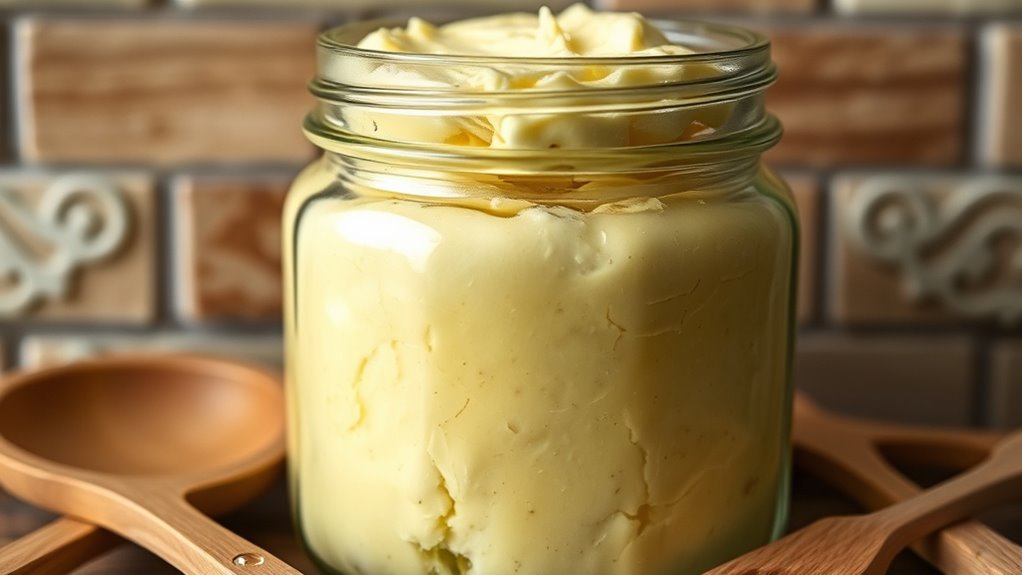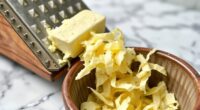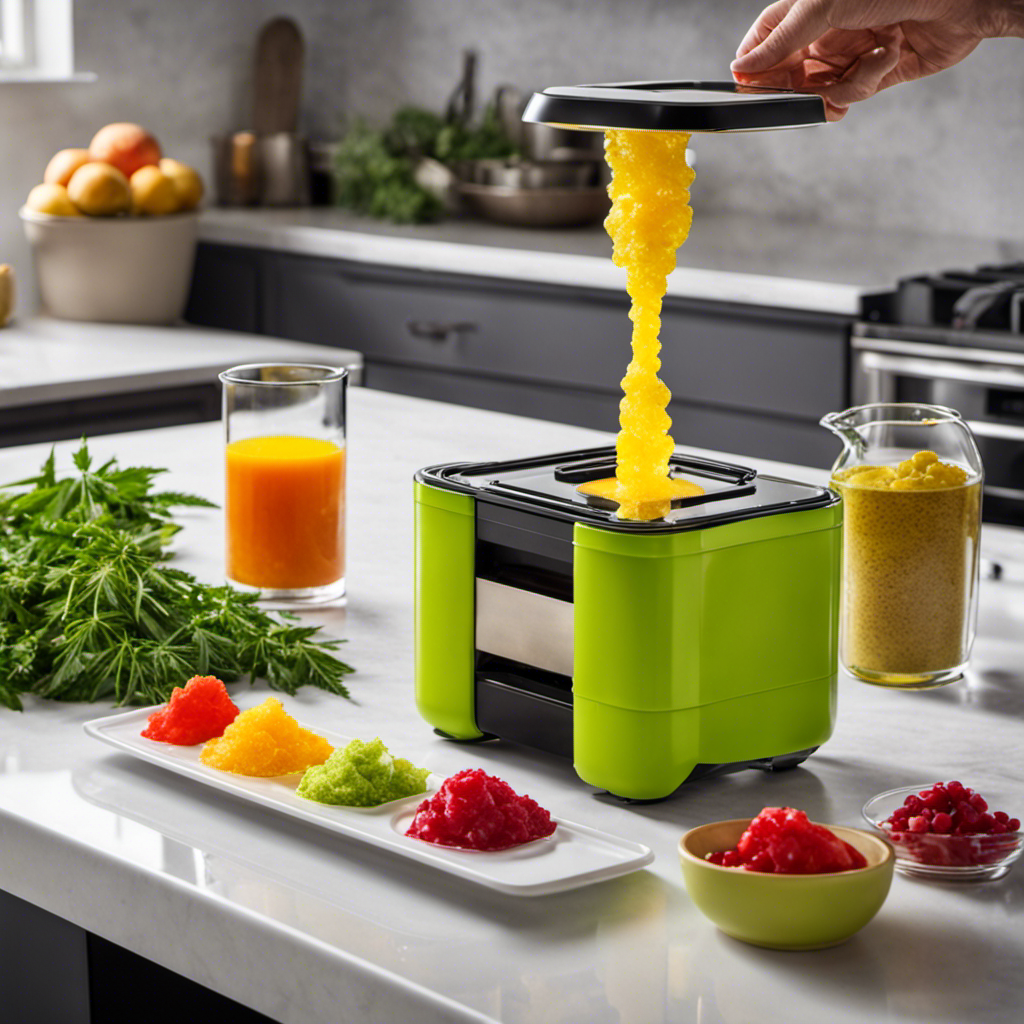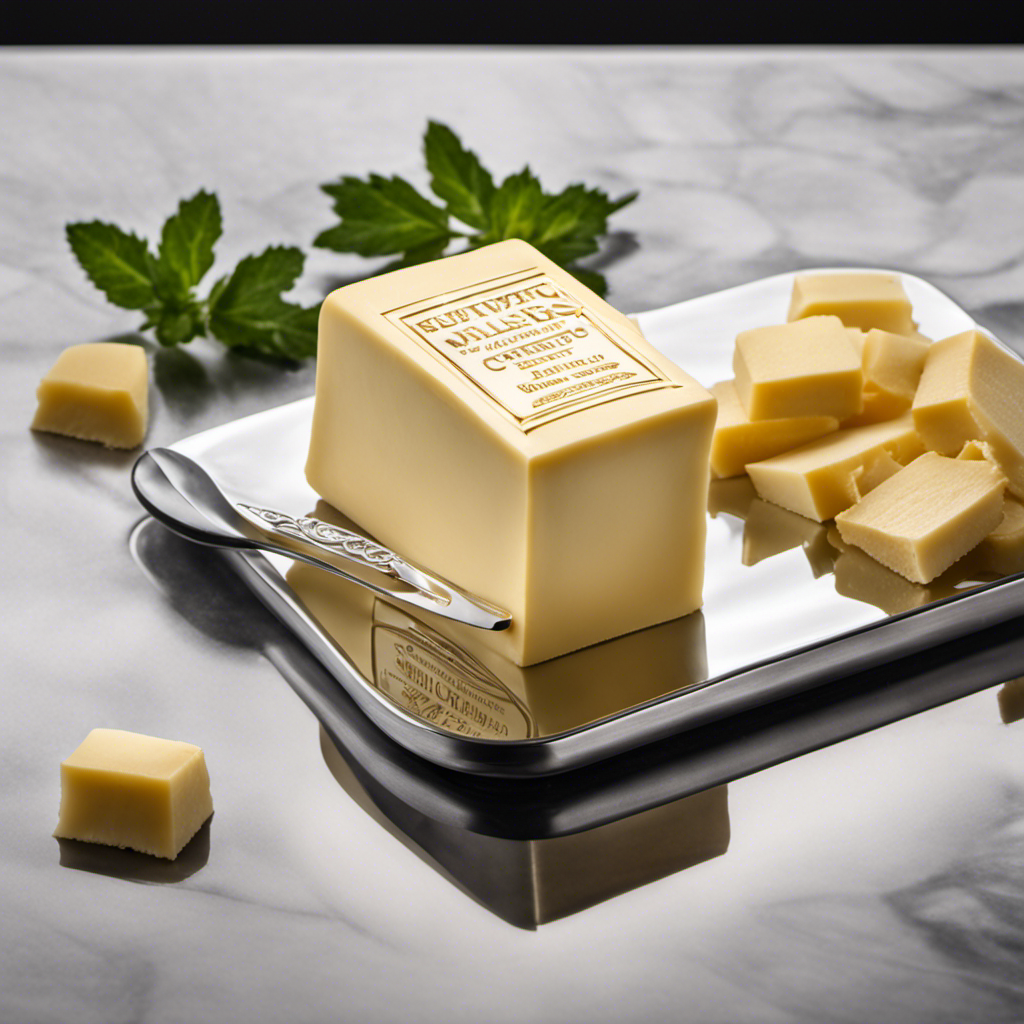To safely revive slightly rancid butter for non-food uses, first inspect it closely—smell, look for discoloration or mold, and guarantee it’s only mildly off. Then, thoroughly clean and melt the butter, strain out impurities, and use gentle heating with odor-absorbing materials like activated charcoal or baking soda to neutralize odors. Proper storage and handling are essential. If you want detailed techniques to restore and repurpose your butter safely, explore further.
Key Takeaways
- Thoroughly inspect the butter for discoloration, off-odor, and mold; discard if spoilage signs are present.
- Gently heat the butter at low temperatures to volatilize and reduce rancid off-flavors.
- Strain through fine mesh and remove excess moisture to stabilize for non-food applications.
- Use odor-absorbing materials like activated charcoal or baking soda to deodorize the butter further.
- Store in airtight, cool, dark containers, and handle with gloves to ensure safety and prevent contamination.
Assessing the Rancidity Level of Your Butter

To determine if your butter has gone rancid, start by inspecting its appearance and smell. Butter’s shelf life varies, but if it’s been stored too long, rancidity indicators become evident. Look for discoloration, such as dark spots or a dull surface, which may signal spoilage. Smell is a reliable indicator—rancid butter often emits a sour, bitter, or stale odor that’s unlike the fresh, creamy scent of good butter. If your butter exhibits any of these rancidity indicators, it’s best to avoid using it for culinary purposes. Checking for these signs helps you decide whether your butter is still good or should be repurposed for non-food uses. Color accuracy and proper inspection techniques are essential for making an informed decision. Accurate assessment guarantees safety and prevents undesirable flavors in your projects.
Proper Techniques for Removing Off-Flavors and Odors

To remove off-flavors and odors from rancid butter, start with thorough cleaning methods that eliminate surface residues. Next, use odor absorption techniques like charcoal or baking soda to neutralize lingering smells. Finally, apply flavor neutralization tips, such as rinsing or adding mild acids, to restore a more acceptable scent and taste. Incorporating proper air purification methods can further improve air quality and help eliminate residual odors in your environment.
Thorough Cleaning Methods
When removing off-flavors and odors from rancid butter, thorough cleaning is essential to restore its usability for non-food purposes. You should start by melting the butter gently, then strain out any solids to eliminate remaining impurities. Next, wash the container with hot water and a mild detergent to remove residual odors. Rinse thoroughly and dry completely before use. Proper kitchen storage, like airtight containers, helps prevent future contamination. Incorporate these cleaning tips to ensure the butter stays fresh for non-food applications. Remember, patience during cleaning is key to fully eliminate lingering odors. A clean, well-maintained container will make your revival efforts more effective. Using dream symbols to identify underlying emotional issues can help you better understand and address the causes of contamination. With proper cleaning, your slightly rancid butter can be repurposed safely and efficiently.
Odor Absorption Techniques
Effective odor absorption begins with choosing the right materials, such as activated charcoal, baking soda, or zeolite, which are known for their porous structures that trap odors. Use these to neutralize rancid butter’s off-flavors during household deodorizing or aromatherapy scenting. To maximize effectiveness, place the materials in breathable bags or open containers near the butter. Additionally, selecting dog names that suit your pet’s personality can enhance your bonding experience.
| Material | Best Use | Additional Tip |
|---|---|---|
| Activated Charcoal | Absorbing strong odors | Change weekly for best results |
| Baking Soda | Household deodorizing | Sprinkle in affected areas |
| Zeolite | Long-lasting odor control | Store in airtight containers |
These techniques safely remove unwanted smells without masking, restoring your space’s freshness.
Flavor Neutralization Tips
After neutralizing unpleasant odors with odor absorption methods, focusing on flavor neutralization guarantees your butter no longer imparts off-flavors to your dishes. To achieve effective butter preservation, you can employ various flavor masking techniques that hide residual rancidity. Start by blending the butter with strong-tasting ingredients like herbs, garlic, or citrus zest, which overpower any remaining off-flavors. Heating the butter gently can also help release volatile compounds responsible for off-flavors, making them easier to neutralize. Additionally, adding a small amount of neutral oil may dilute unpleasant tastes without compromising quality. Finally, consider using natural flavor enhancers such as vanilla or spices to further mask residual rancidity, ensuring your butter remains suitable for non-food uses while maintaining its utility in your projects. Understanding sustainable practices can also help you find eco-friendly ways to manage kitchen waste and reuse ingredients safely.
Preparing the Butter for Non-Food Applications

To prepare rancid butter for non-food uses, start by removing excess moisture to prevent spoilage. Next, clarify and filter the butter to eliminate impurities and improve its consistency. Additionally, incorporating proper storage techniques in a cool, airtight container helps maintain its quality over time.
Remove Moisture Content
Have you ever wondered how to transform rancid butter into a suitable non-food product? Removing moisture is essential to improve its butter flavor and butter texture for non-food uses. To do this effectively, you need to:
- Gently heat the butter at low temperature to evaporate water without burning
- Use a double boiler or low oven to control heat evenly
- Continuously stir to prevent separation or scorching
- Ensure thorough drying by spreading the butter thinly on a surface or using a dehydrator
- Incorporate automation’s role in data processing to monitor moisture levels and optimize drying times for consistent results
This process minimizes water content, concentrates flavors, and stabilizes the butter for applications like cosmetics or crafts. Proper moisture removal creates a more stable, consistent base while preserving the desired butter flavor and butter texture for your project.
Clarify and Filter
Once the moisture has been removed, the butter still contains impurities like milk solids and residual fats that can affect its clarity and performance in non-food applications. To achieve a clean, stable product, you need to clarify the butter through gentle heating, which separates the milk solids from the pure fat. Strain the melted butter through a fine cloth or filter to remove any remaining particles. This process mirrors steps in butter manufacturing and food preservation, ensuring the butter is free of impurities that could cause rancidity or cloudiness. Clarifying and filtering improve the butter’s stability and transparency, making it suitable for various non-food uses such as cosmetic formulations or industrial applications. Properly clarified butter will last longer and perform more effectively in your projects. Additionally, understanding how Merkle trees maintain data integrity can be analogous to how clarification ensures purity and stability in your butter.
Ensure Proper Storage
Proper storage is essential to maintain the quality and longevity of clarified butter for non-food uses. To prevent spoilage and preserve its properties, choose appropriate packaging materials that are airtight and non-reactive, such as glass jars or metal containers. Keep the butter at a consistent storage temperature, ideally cool and dark, around 50°F (10°C), to slow down rancidity. Avoid exposure to direct sunlight or fluctuating temperatures, which can accelerate spoilage. Ensure containers are tightly sealed after each use to prevent contamination and oxidation. Proper storage not only preserves the butter’s effectiveness for non-food applications but also minimizes odor transfer and deterioration over time. Regularly check stored butter for signs of spoilage, and always store in a clean, dry environment. Monitoring storage conditions helps maintain the butter’s integrity and extends its usability for various non-food purposes.
Safe Methods to Rejuvenate Slightly Rancid Butter
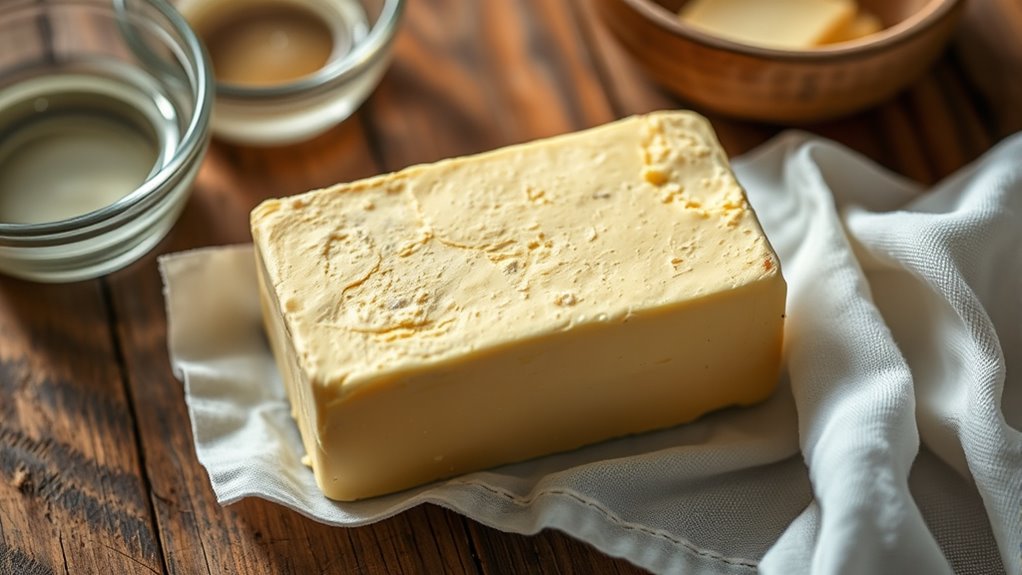
If your butter has only just begun to turn rancid, you can often restore it using simple, safe techniques. One effective method is to gently heat the butter in a double boiler or microwave at low power. This process can help reduce the sharp, off-putting butter flavor caused by rancidity. As you do this, the butter texture becomes smoother and more uniform. Be careful not to overheat, as high temperatures may worsen the rancid flavor or degrade the butter further. Once warmed, strain the butter through a fine mesh to remove any impurities. This method doesn’t eliminate the rancid taste entirely but can improve the butter’s aroma and consistency, making it more suitable for non-food uses like craft projects or skincare preparations. Incorporating emotional intelligence during the process can help you assess the butter’s condition and determine if the rejuvenation is successful.
Creative Non-Food Uses for Revived Butter

Revived butter, even if it has a slight rancid smell, can find surprising new life in various non-food applications. Its unique properties make it useful beyond the kitchen, especially when considering the right butter packaging and storage temperature. You can use it as a natural lubricant for machinery or hinges, thanks to its greasy consistency. It also serves as a base for creating homemade candles, where the scent adds a rustic touch. Additionally, revived butter can be used in craft projects, like making textured art or natural dyes. Before repurposing, guarantee proper storage temperature to prevent further spoilage. Just remember, its effectiveness depends on how well you store it and whether you’ve neutralized any odor beforehand.
- Lubricating small mechanical parts
- Making rustic candles with natural scents
- Applying in craft projects for texture
- Creating natural dyes from leftover butter
Precautions and Tips for Safe Handling and Storage
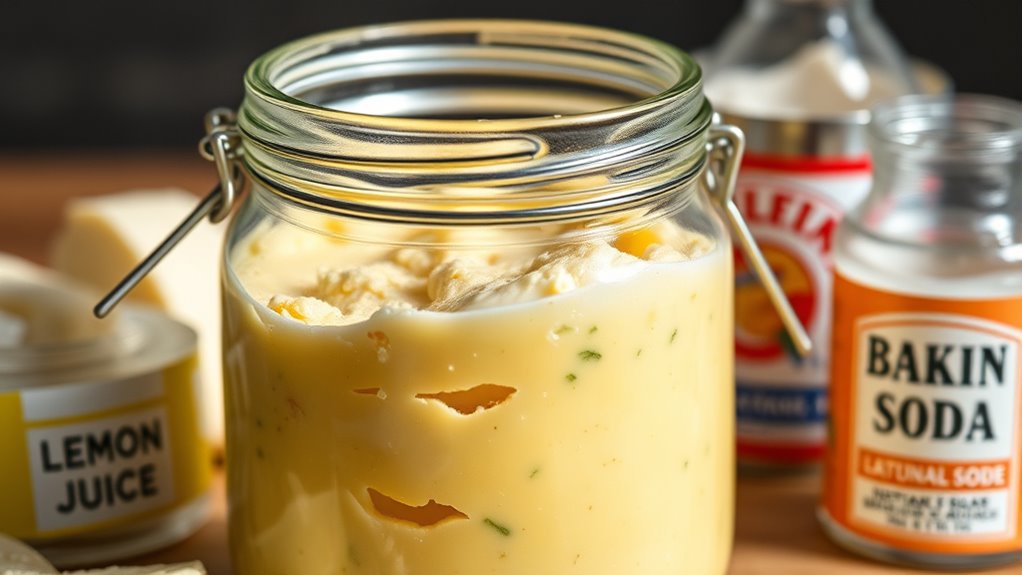
To guarantee safe handling and storage of revived butter, you should always inspect it thoroughly before repurposing. Check for unusual odors, discoloration, or mold, as these indicate spoilage. Handling safety is essential; wear gloves when working with rancid butter to prevent skin irritation. Follow proper storage guidelines by keeping the butter in an airtight container in a cool, dry place, away from direct sunlight. Avoid leaving it out at room temperature for extended periods, as this can promote bacterial growth. Label the container clearly to prevent accidental misuse. Regularly monitor the stored butter for changes in smell or appearance. Proper handling safety and storage ensure you can reuse the butter effectively without risking health or creating messes.
Frequently Asked Questions
Can Rancid Butter Be Used as a Natural Lubricant Safely?
Using rancid butter as a natural lubricant isn’t recommended. Its safety precautions highlight potential skin irritation and bacterial growth, making it unsuitable for intimate or skin contact. Instead, explore alternative uses like homemade soap or conditioning treatments, but always prioritize safety. Remember, rancid butter’s odor and bacteria pose risks, so it’s best to avoid using it as a lubricant and choose safer, approved options for personal needs.
How Long Does the Rejuvenation Process Typically Take?
You might worry about the time needed for butter aging and rejuvenation. Typically, the rejuvenation timeline for slightly rancid butter takes about a week. During this process, you’ll notice the butter’s smell and texture improve as it loses some of its rancid qualities. Keep in mind, patience is key. With proper care, you can restore butter’s usefulness for non-food applications within this period, making the effort worthwhile.
Are There Any Environmental Benefits to Repurposing Rancid Butter?
You might wonder if repurposing rancid butter offers environmental benefits. Doing so reduces waste and minimizes the environmental impact of disposal, promoting sustainability. By finding alternative uses, you help lower landfill contributions and resource consumption. This practice supports eco-friendly initiatives and encourages a circular economy, where materials are reused creatively. Overall, repurposing rancid butter enhances sustainability benefits and contributes positively to environmental conservation efforts.
What Are the Signs of Successful Revival for Non-Food Uses?
Imagine giving your butter a gentle makeover—success shows in a pleasant odor change and smoother texture. When reviving slightly rancid butter for non-food uses, look for a milder smell and improved consistency, indicating the revival process is working. If the odor lightens and the texture becomes more pliable, you’re on the right track. These signs show your effort has successfully transformed the butter into a useful, eco-friendly resource.
Is It Safe to Use Revived Butter on Sensitive Skin?
Using revived butter on sensitive skin isn’t recommended because it may cause skin sensitivity or allergy risks. Even if the butter seems fine, rancid components can irritate delicate skin. Always patch-test a small area first, and consult a dermatologist if you’re unsure. It’s safer to avoid applying it directly to sensitive skin, especially if there’s any doubt about how well it’s been revived or if it might still contain residues.
Conclusion
By carefully evaluating and treating your slightly rancid butter, you turn a potential waste into a versatile resource. With proper techniques, you can safely revive it for non-food uses, transforming a flaw into an opportunity. Think of it as giving new life to what once seemed spoiled—an act of renewal that’s both resourceful and eco-friendly. Embrace these methods, and you’ll find that even imperfect butter can serve a purpose beyond the kitchen.
